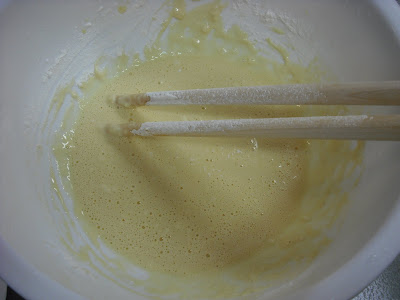Note: This post was initially published between Tempura Making 1 and Tempura Making 3, but was published as a new post here after I corrected Blogger-created stupid label to the initial one. Sorry for the inconvenience.
注: この投稿は最初、Tempura Making 1とTempura Make 3の間に発行したのですが、Bloggerが作成した変なラベルを最初のラベルに修正したら、新たな投稿として、ここに発行されてしまいました。ご了承下さい。
I forgot to mention that I had made all the necessary preparations for the tempura ingredients before pouring oil into the pot.
言い忘れましたが、鍋に油を注ぐ前に、天ぷらの具材の下準備をすべてしました。
I then turned on the stove, and started to make tempura batter.
次にコンロの火をつけて、天ぷらの衣を作り始めました。
The standard tempura batter is a 1:1 mixture of (beaten egg + cold water) and wheat flour, but for this particular tempura making session, I decided to make batter with beaten egg yolk + cold water and wheat flour. By cold water, I mean tap water at about 21C. Cold water of about 15C is preferable but not essential, and you need not use iced water, in my opinion. For best results, the flour must be low-gluten flour like cake flour (kakurikiko in Japan). All-purpose flour (churikiko in Japan) should be OK (I have made tempura with churikiko with success several times), but don't use bread flour (kyorikiko in Japan).
標準的な天ぷらの衣とは、(溶き卵+冷水)と小麦粉を1:1で混ぜたものですが、今回の天ぷら作りでは、(溶いた黄身+冷水)と小麦粉で衣を作ることにしました。冷水と私が言うのは、21度程度の水道水です。15度程度の冷水のほうがいいですが、必須ではありません。また、私の意見ですが、氷水を使う必要もありません。良い結果を出すには、cake flourなどのグルテンの少ない小麦粉(日本では薄力粉)を使ってください。all-purpose flour(日本では中力粉でも大丈夫ですが(何回か中力粉で天ぷらを作りましたが、うまく行きました)、bread flour(日本では強力粉)は使わないで下さい。
Beaten egg yolk + Cold water, mixed thoroughly, the total amount of which should be 200 ml to combine with 200 ml flour to make batter):
溶いた卵の黄身と冷水を良く混ぜたところ。合計200 mlになること(200 mlの小麦粉と合わせて衣を作るには):
If you try tempura making for the first time, I recommend measuring the flour. 200 ml or 110 g flour. And, about 175 ml cold water to make a yolk solution of 200 ml.
天ぷら作りを初めて試すなら、小麦粉の量を測ることを薦めます。小麦粉200 mlまたは100 g。それから、200 mlの冷水を黄身の溶液を作るために約175 mlの冷水。
Sift flour and add it to the yolk solution (not vice versa).
小麦粉をふるって、黄身の溶液に入れます(逆ではなく)。
Mix thoroughly (but don't overmix). Some people may tell you that the batter should be lumpy, but it need not necessarily be lumpy, in my opinion.
良く混ぜます(でも混ぜ過ぎない)。ダマが残っていなければいけないと言う人がいるかも知れませんが、私としては、必ずしもそうである必要はないと思います。
I usually start making tempura with vegetables, like many others, but I started with prawn this time, so that my hungry son could start having tempura soon. I heated the oil to 180C (my stove is equipped with a temperature control), and deep-fried prawn for about 1.5 min.
普段は、他の人と同様、天ぷらは野菜から作り始めるのですが、お腹をすかせた息子が早く天ぷらを食べれるよう、今回はエビから始めました。油を180度に加熱し(コンロには温度調節がついています)、エビを約1.5分、揚げました。
Not good examples! The prawn ended up curling, although I made several cuts on the belly side of each prawn and bent each prawn in the opposite direction.
良くない例です。エビの腹側に切り込みを幾つか入れ、反対方向に曲げたのですが、エビは丸まってしまいました。
To be continued.
続く。
Subscribe to:
Post Comments (Atom)





4 comments:
Hiroyuki, thank you for these detailed explanations and step-by-step photos. Your posts will be my official tempura guide :-) I have read about the belly cuts in a Japanese cooking book, but have never tried it. I am very curious about the remaining ingredients!
Sissi: Thanks for your comment, which has been deleted by Blogger probably in an attempt to correct a problem they had.
I have the book you mentioned, and I know the passage you are referring to:
... and then lightly tap across each shrimp with back of knife blade.
(page 237)
And I know this doesn't work!!
I will write about prawn preparations in a future post.
Thank you Hiroyuki for this message. Since afterwards I couldn't access your blog for some time I though there were some problems in blogger. No problem, I already talk too much on your blog ;-)
Such a pity it doesn't work.. but your prawns are not completely curled either! Even though this trick doesn't work, I consider the Japanese Cooking by far the best cookery book I have ever had!
Post a Comment